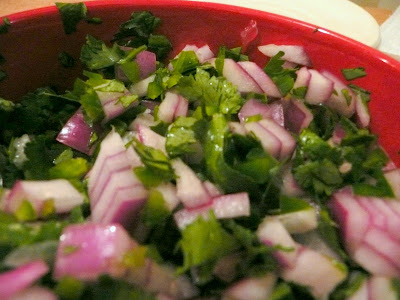The problem I'm having is that most of what I want from Japan isn't the type of thing that you can put in a suitcase and carry around with you - it's less tangible than that. What I want is the feeling of being there, of walking down the streets, taking unexpected turns into tiny alleys and finding a half-forgotten shrine next to a Tokyo department store or pachinko parlor; the long, winding, steep cobbled roads up to the waterfall at Kiyomizu Dera in Kyoto; the late-night train rides home, watching reflections in the opposite window of the half-empty car; learning to doze standing upright in the morning rush hour crush of passengers and not missing your stop. I want the festivals - I want the language - I want the unmarked streets and semi-incomprehensible signs - the frustration of not being able to read completely, the satisfaction when I recognize the occasional kanji.
I also miss the food, but luckily that's something I can usually recreate at home - like okonomiyaki.

Okonomiyaki is usually described as a "Japanese stuffed pancake," which isn't right at all. That said, I don't really know what is right. It is pancake shaped, yes, and fried on a griddle or in a pan. There is a batter, made with dashi or water, flour, yama-imo (mountain yam) and egg, then mixed with shredded cabbage, green onion, benishoga (pickled ginger), and the meat/seafood of your choice. In some districts they add noodles - but that's not the style in Nagoya, where I used to live. And then there is the sauce - sort of a Japanese barbecue sauce - and Japanese mayonnaise (totally different than American mayonnaise). Suffice to say, it sounds odd, looks a little odd, and tastes fantastic. And except for the benishoga and Japanese mayonnaise (which you should be able to find at your nearest asian/Japanese grocery), everything is pretty easy to come by.
Okonomiyaki
adapted from Hiroko Shimbo
for the sauce:
1/2 cup tomato ketchup
3 tablespoons Worcestershire sauce
1/2 teaspoon smooth French-style mustard
1/4 cup mirin
2 tablespoons sugar
2 teaspoons shoyu (soy sauce)
for okonomiyaki:
1 cup flour
1 cup water or dashi
1/2 teaspoon salt
3 tablespoons grated yama-imo (you can use potato starch in a pinch, or skip it altogether in an even pinchier pinch)
4 ounces green cabbage, shredded
1/4 cup green onions, sliced into rounds (I use the white and the lighter green parts)
2 tablespoons minced benishoga (note - this is red pickled ginger, not the kind you get with sushi!)
4 ounces beef sirloin, cut into thin strips
6-8 large-ish shrimp, shelled, deveined and sliced in half lengthwise
2 eggs
vegetable or canola oil
To make the sauce:
In a small saucepan, combine all ingredients. Bring to a boil and cook over low heat for 3 minutes. Remove from heat and set aside. Serve warm, or at room temperature (I prefer mine warmish).
To make the okonomiyaki:
First off, here is a dashi recipe. You can definitely skip the dashi and just use water, but if you have the time/energy, I definitely recommend dashi.
Sift flour into a bowl, add the dashi (or water), salt and grated yama-imo (or potato starch), and stir to mix. Divide the batter between two bowls, and put half of the cabbage, green onions, benishoga, beef and shrimp into each bowl. Add one egg to each bowl, and mix to combine.
Over medium-high heat, in a large skillet or on a griddle, heat enough vegetable oil to coat the bottom of the pan. When it is hot, pour the batter from one bowl into the skillet and spread the batter into a disk about 8 inches in diameter. Leave yourself a little room on either side to fit spatulas in later. Lower heat to medium and cook until the bottom is golden.
Then comes flipping, the most difficult part of okonomiyaki. You have a fairly loose, large pancake-like object in the pan, about eight inches across and perhaps three-quarters of an inch thick. To flip it, you'll need two spatulas, wrist strength, and nerves of steel: as such, Matt is the official okonomiyaki-flipper in our house.
First goes one spatula.

Take a deep breath, lift, and commit - that's the key. You can't be afraid of the okonomiyaki during the flipping, or it will fall apart on you. (I've found the same is true of flipping fried eggs - the yolk always knows I'm scared, and it takes advantage of that and breaks.)
If it falls apart terribly, scoot the pieces back together and soldier on - it'll still taste good. Cook until the other side is golden and the middle is set (ish).
Divide into quarters and plate, topping with plenty of sauce and mayonnaise. (We didn't have the right kind of mayonnaise, so we just ate it with the sauce - also very okay!)
If necessary, heat a little more oil in the pan before adding the second bowl of batter - let this one cook while you eat the first one. They make decent leftovers, too, if you're full after round one.
Oh, and start saving for your next trip to Japan.










